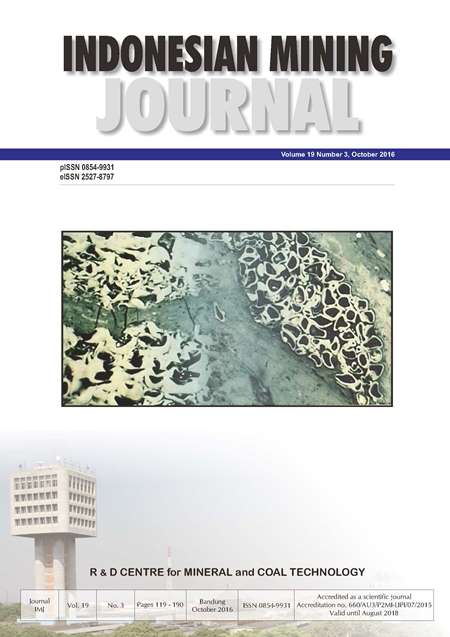Indexed by:
Vol. 19 No. 3 (2016): INDONESIAN MINING JOURNAL VOL. 19 NO. 3, October 2016

This is the last journal edition of 2016 that is completely published three times annually. Unfortunately, in this opportunity, we would like to inform you that starting 2017, this journal will be periodically published twice annually, which is in April and October. The editors has decided this situation due to technical and administrative reasons. We hope that all authors consistently contribute articles for this journal. For all authors who have contributed all articles for the 2016 edition, it is highly appreciated. The editors thank you for contributing all interesting and promising articles, particularly in supporting the value added mineral and coal and implementing the good mining practices in this country.
To close the end of this year, it is significantly reminded that the export permit for mineral will finish on January 11th, 2017 according to the Ministerial Regulation Number 1 Year 2014. The government is predicted to face a dilemma regarding the export permit. An effort to preparing a new policy or revising the existing policy clearly creates problems. This issue is an impact of not completing yet the revision of Law Number 4 Year 2009 concerning Mineral and Coal Mining.
The crucial points of the mining issues in this country are still dominated by the implementation of good mining practices and value added issues, particularly in implementing the application of the above mining law. Those issues are really significant, because in the early 2014, this law has officially been implemented. All raw minerals may not be exported prior to being processed in smelters. However, the mineral product grade (concentrate) may be exported for a limited time for mining companies in completing the construction of smelter until January 2017. It was predicted by many economists and related experts from academic communities. This regulation absolutely become a guidance of the implementation to ban export of ores in the early 2014. Even for nowadays, President Joko Widodo strictly supervises the implementation of the regulation. Supporting this supervision, the Indonesia’s Corruption Eradication Commission (Komisi Pemberantasan Korupsi-KPK) is seriously involved to the verification of the mining activities in the country in implementing those issues. To implement this action, a joint team of KPK and Puslitbang tekMIRA) has carried out verification of legal aspects for the operation of mineral and coal mining operation in Kalimantan.
It is predicted that the government must cope with the impacts that can happen when the regulation implemented. One of these impacts absolutely includes termination of employment. The problem, of course, will be a concern for the mining employees. For this reason, the government should give a policy that still permit to export concentrate with certain grade limits until the construction of smelters. Besides saving the employees, this regulation can be a concession for regional economy, because the mining operation still carries out.
Articles related to this law emphasise that holders of mining licences must increase value added of mineral and coal resources in the implementation of mining operation, processing and utilisation. The holders of mining licence of operation and production must domestically conduct process the mineral and coal. It is also stressed that environmental issues are the main points to be managed wisely. In addition, most small-scale mining always gives rise to degraded environment and causes air and water pollution to the communities around the mining operation. This issue must be solved in order to create a healthy environment and to make a harmonious living between the mining company and the surrounding communities.
As usual, five articles published in this journal are contributed by researchers and lecturers from R&D institutions and universities. Some of the authors are well-known figure for their discipline and have contributed their brilliant ideas to improve the mineral and coal technology. The rest is young researchers who are interested in managing a good environment due to mining operation in this country. From all the papers published in this journal, R&D institutions should do something new to anticipate all the above challenges rather than to cope with all problems. It is really expected that the Law 4/2009 and related regulations must be implemented to accommodate the good mining practices and value added issues including the aspects of exploration, mining environment and economics of the mineral and coal commodities, which are perfectly processed in line with the user demands. Of course, this opportunity should be developed and this is a big challenge for researchers and engineers to prove their capabilities for the better future in the energy and mining sector of this country.











